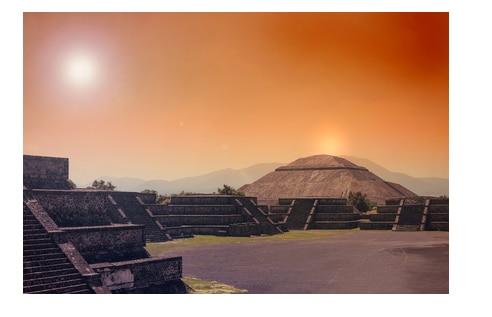- The archeological zone of Teotihuacán, México, is located approximately 40 miles northeast of México City. There is little doubt that Teotihuacán was a major city-state that housed a complex urban society.
- Teotihuacan was established in the year 200 B.c.
- The Teotihuacan were descendants of the Totonac people.
- The Teotihuacan people spoke Nahuatl language.
- The Pyramid of the Sun determined the orientation of the city.
- At the beginning of the Teotihuacan, culture society was matriarchal.
- Teotihuacan archaeology was based on the construction of slope and board with a perfect alignment of temples, palaces, residential neighborhoods, markets, craft sites and large squares for religious festivals, altars, etc.
- The Teotihuacan worshiped various gods, so they were polytheistic.
- The most important pyramids are the Temple of the Sun and of the Moon.
- The Pyramid of the Moon and its ceremonial square were called the Palace of Quetzalcoatl, which means divine butterfly.
- The stairs of the pyramid of the Sun are sinuous with precise measurements: the depth of each step is the size of a foot.
- They used the technique of ornamental pilasters with relief, battlements with plaster on the facades and stone buildings. They decorated their buildings with fresco murals.
- Dances were part of the ceremonies dedicated to the different deities such as fertility, the Earth, the Sun, Quetzalcoatl.
- The musical instrument in the ceremonies were certain types of flutes made of clay which produced very sharp notes and accompanying bells.
- The cure of diseases was carried out through mysticism and the use of natural remedies; mixing science and religion that would give way to Mexican Herbology.
- The people of Teotihuacan were farmers. The main crops they harvested were corn, pumpkin, nopal and maguey.
- Tools for cultivation came from obsidian and rocks, as the mixed stone, to process the fiber of maguey.
- Their clothes were made from maguey fibers and colored with pigments extracted from plants and minerals.
- They well excellent ceramists; they modeled beautiful vases with lids, zoomorphic and anthropomorphic vessels with orange terracotta clay.
- They created jewels and headdresses with Quetzal feathers, sea shells, jade, cocoa, copal (Burseraceae), and cotton.
- Today Teotihuacan is designated as a Cultural Heritage of Humanity.


